Organisational Design and Management Essay: Culture and Stakeholders
VerifiedAdded on 2023/06/07
|9
|2972
|458
Essay
AI Summary
This essay, written for the HR5053QA module, delves into the multifaceted aspects of organisational culture within contemporary firms. It identifies key elements such as innovation, attention to detail, emphasis on outcome, teamwork, and stability. The essay explores the implications of these cultural aspects on both the organisation and its stakeholders, drawing upon frameworks like Hofstede's cultural dimensions and Kluckhohn & Strodbeck’s Cultural Dimensions to analyze diverse business environments. Furthermore, it examines the positive impacts of a strong organisational culture, including increased employee engagement, reduced staff turnover, and enhanced productivity, while also addressing the role of brand image and reputation. By examining real-world examples and theoretical underpinnings, the essay provides a comprehensive analysis of how organisational culture influences the structure, operations, and overall success of modern businesses.
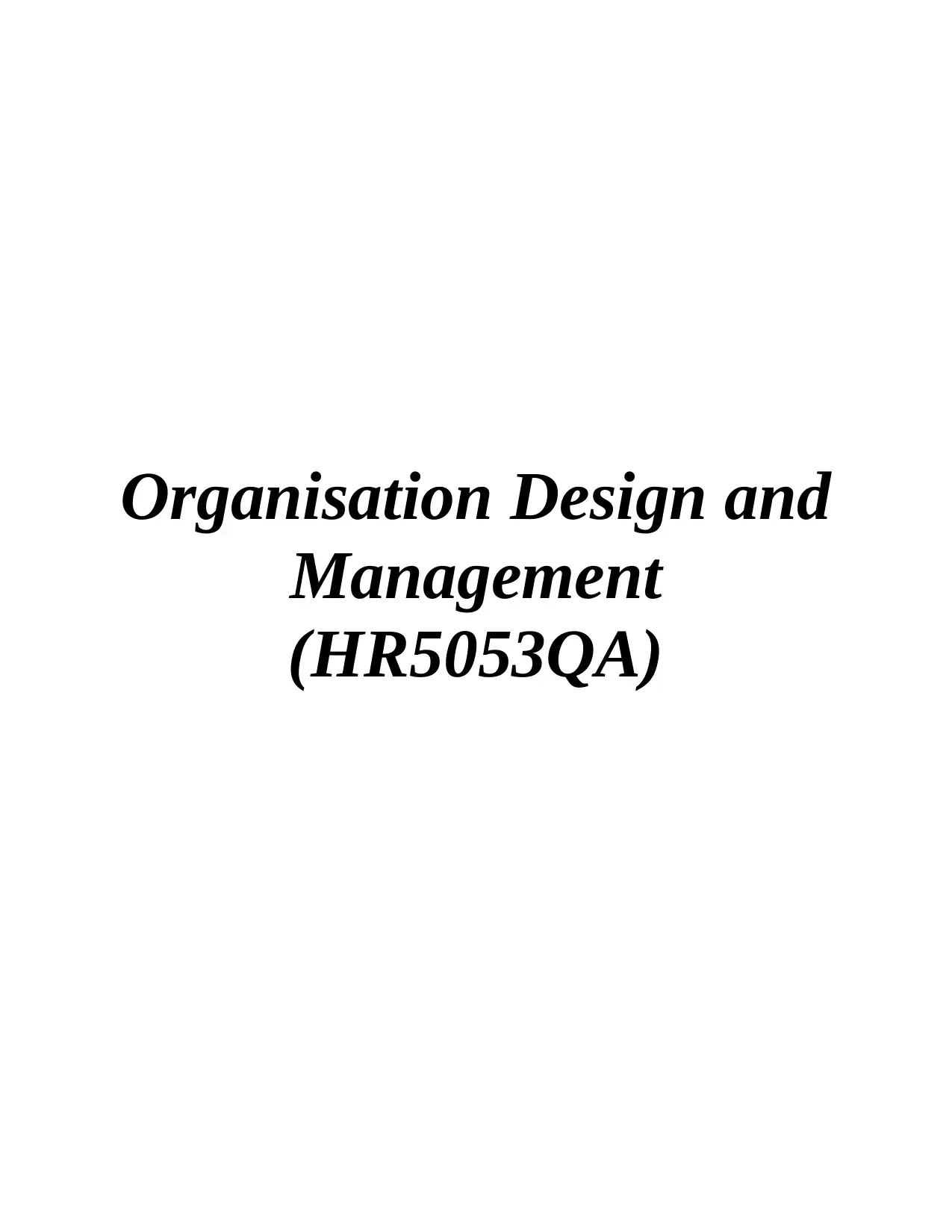
Organisation Design and
Management
(HR5053QA)
Management
(HR5053QA)
Paraphrase This Document
Need a fresh take? Get an instant paraphrase of this document with our AI Paraphraser
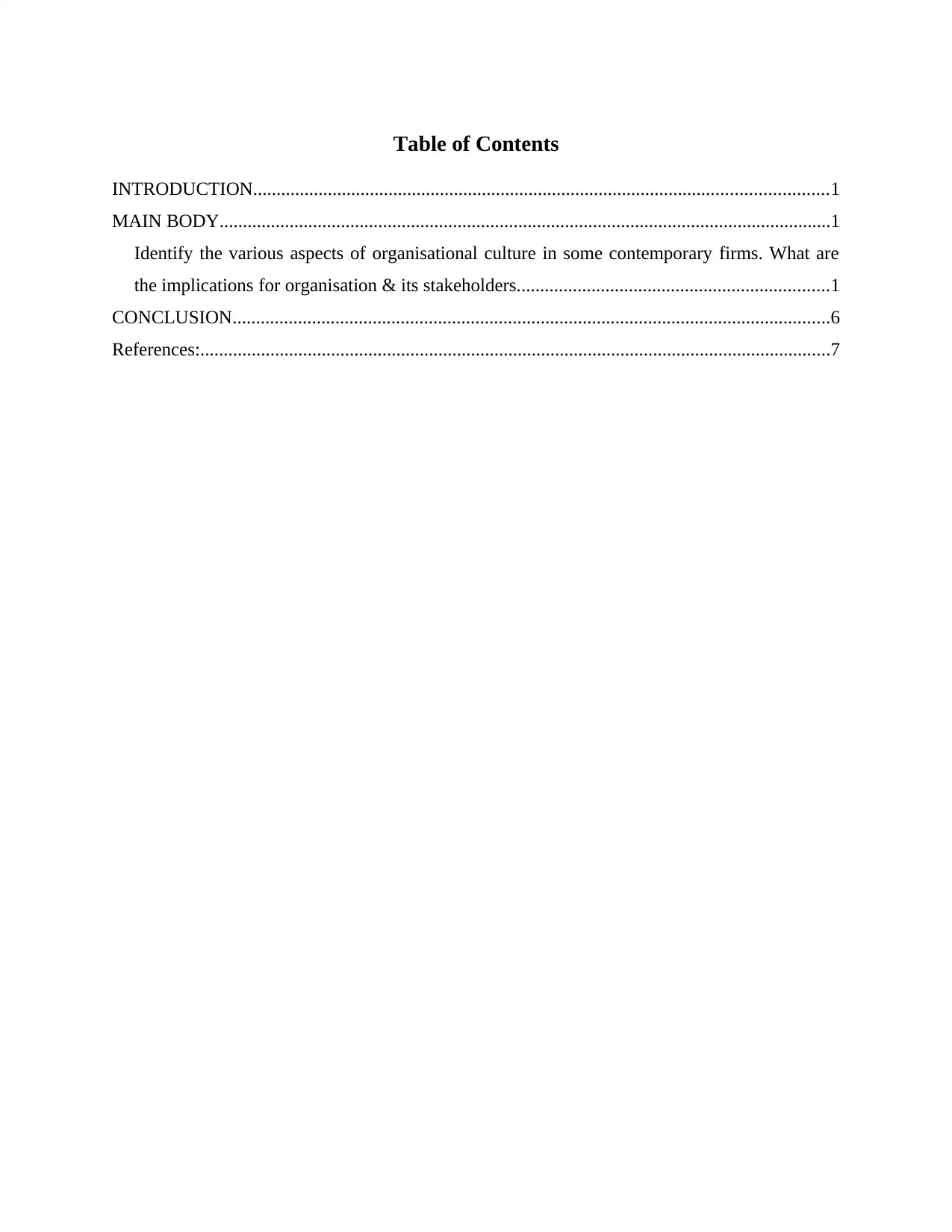
Table of Contents
INTRODUCTION...........................................................................................................................1
MAIN BODY...................................................................................................................................1
Identify the various aspects of organisational culture in some contemporary firms. What are
the implications for organisation & its stakeholders...................................................................1
CONCLUSION................................................................................................................................6
References:.......................................................................................................................................7
INTRODUCTION...........................................................................................................................1
MAIN BODY...................................................................................................................................1
Identify the various aspects of organisational culture in some contemporary firms. What are
the implications for organisation & its stakeholders...................................................................1
CONCLUSION................................................................................................................................6
References:.......................................................................................................................................7
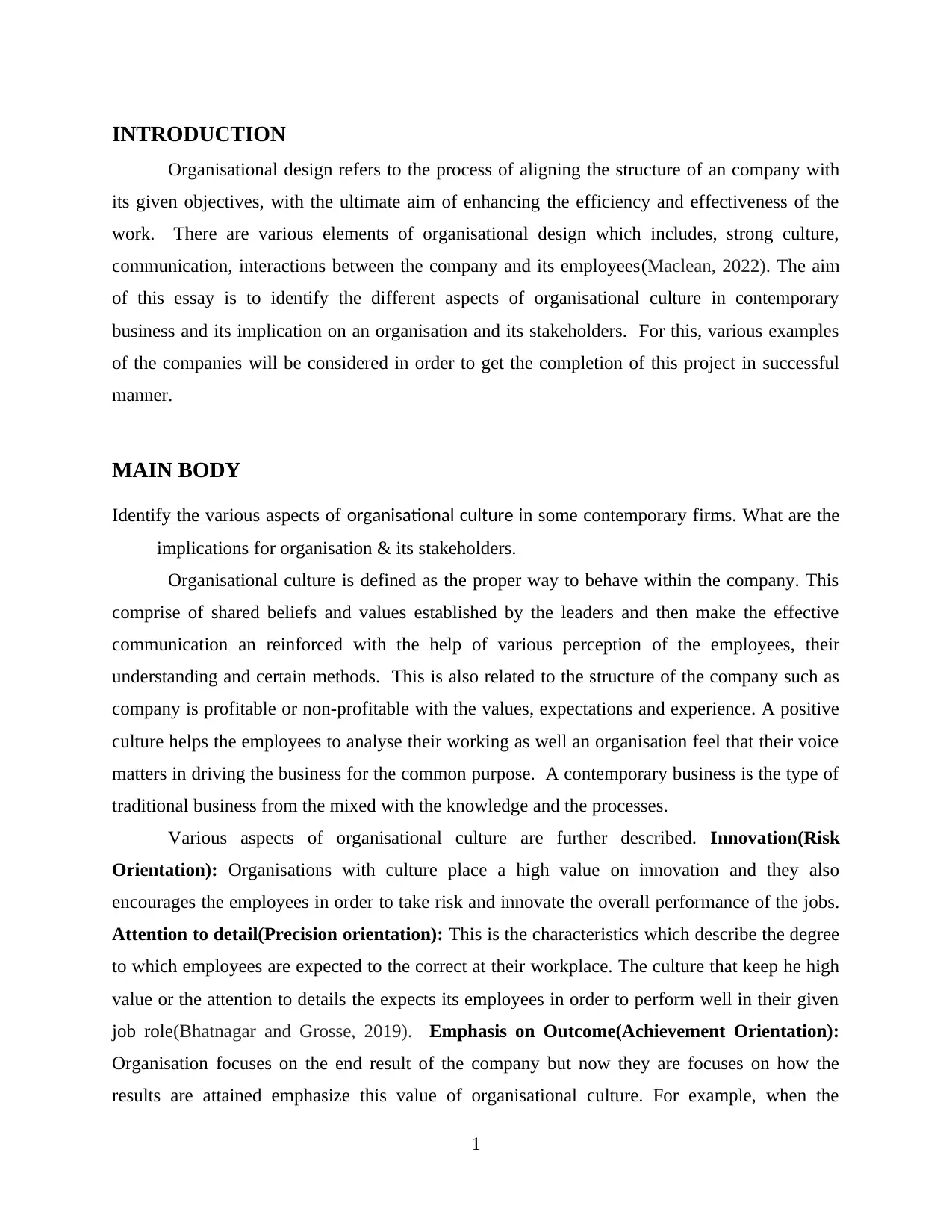
INTRODUCTION
Organisational design refers to the process of aligning the structure of an company with
its given objectives, with the ultimate aim of enhancing the efficiency and effectiveness of the
work. There are various elements of organisational design which includes, strong culture,
communication, interactions between the company and its employees(Maclean, 2022). The aim
of this essay is to identify the different aspects of organisational culture in contemporary
business and its implication on an organisation and its stakeholders. For this, various examples
of the companies will be considered in order to get the completion of this project in successful
manner.
MAIN BODY
Identify the various aspects of organisational culture in some contemporary firms. What are the
implications for organisation & its stakeholders.
Organisational culture is defined as the proper way to behave within the company. This
comprise of shared beliefs and values established by the leaders and then make the effective
communication an reinforced with the help of various perception of the employees, their
understanding and certain methods. This is also related to the structure of the company such as
company is profitable or non-profitable with the values, expectations and experience. A positive
culture helps the employees to analyse their working as well an organisation feel that their voice
matters in driving the business for the common purpose. A contemporary business is the type of
traditional business from the mixed with the knowledge and the processes.
Various aspects of organisational culture are further described. Innovation(Risk
Orientation): Organisations with culture place a high value on innovation and they also
encourages the employees in order to take risk and innovate the overall performance of the jobs.
Attention to detail(Precision orientation): This is the characteristics which describe the degree
to which employees are expected to the correct at their workplace. The culture that keep he high
value or the attention to details the expects its employees in order to perform well in their given
job role(Bhatnagar and Grosse, 2019). Emphasis on Outcome(Achievement Orientation):
Organisation focuses on the end result of the company but now they are focuses on how the
results are attained emphasize this value of organisational culture. For example, when the
1
Organisational design refers to the process of aligning the structure of an company with
its given objectives, with the ultimate aim of enhancing the efficiency and effectiveness of the
work. There are various elements of organisational design which includes, strong culture,
communication, interactions between the company and its employees(Maclean, 2022). The aim
of this essay is to identify the different aspects of organisational culture in contemporary
business and its implication on an organisation and its stakeholders. For this, various examples
of the companies will be considered in order to get the completion of this project in successful
manner.
MAIN BODY
Identify the various aspects of organisational culture in some contemporary firms. What are the
implications for organisation & its stakeholders.
Organisational culture is defined as the proper way to behave within the company. This
comprise of shared beliefs and values established by the leaders and then make the effective
communication an reinforced with the help of various perception of the employees, their
understanding and certain methods. This is also related to the structure of the company such as
company is profitable or non-profitable with the values, expectations and experience. A positive
culture helps the employees to analyse their working as well an organisation feel that their voice
matters in driving the business for the common purpose. A contemporary business is the type of
traditional business from the mixed with the knowledge and the processes.
Various aspects of organisational culture are further described. Innovation(Risk
Orientation): Organisations with culture place a high value on innovation and they also
encourages the employees in order to take risk and innovate the overall performance of the jobs.
Attention to detail(Precision orientation): This is the characteristics which describe the degree
to which employees are expected to the correct at their workplace. The culture that keep he high
value or the attention to details the expects its employees in order to perform well in their given
job role(Bhatnagar and Grosse, 2019). Emphasis on Outcome(Achievement Orientation):
Organisation focuses on the end result of the company but now they are focuses on how the
results are attained emphasize this value of organisational culture. For example, when the
1
⊘ This is a preview!⊘
Do you want full access?
Subscribe today to unlock all pages.

Trusted by 1+ million students worldwide

organisation instruct their sales force too increase the sales whatever it takes has the culture that
keep high value on the outcome characteristics.
Teamwork(Collaboration Orientation): Organisation that manage the overall work
around the team instead to an individual, place a high degree of organisational culture. They
ensure the positive relationship with the co-workers and the managers.
Aggressiveness(Competitive Orientation): This attribute says that the organisational culture
set aggressiveness place a high value on the competitiveness and outstanding performance in the
target market in order to get the better results to get the better outcome. Stability(Rule
Orientation): These are the firms which ensures the work is to be done with the rules and
predictable and bureaucratic in nature so that they can establish the good position in the target
market. All the work should be done with consistent and predictable levels of outputs.
Hofsteda's cultural dimension
This is the framework which helps in analysing the culture of any business organisation
or the nation in which they are operating in. this helps them to have the better consideration by
which they can comply with the emerging market trends and the taste and perception of their
target audience. There are various cultural dimension on which the nations can be ranked and
that are illustrated(Barnard, 2022). Power Distance: This is the dimension which is expresses
the degree in that the individual is having less power in the society accept the decision. As the
power is unequally distributed among the people. It is the main concern due to which the society
ave to face various issues and inequalities among the individual. In high degree of power
distance, all the decisions are being made in hierarchical order in which people ave their own
place. On other hand, people ask for the justification in order to eliminate the inequalities of the
power among them. There is low score for the UK in context to the distance in which suggest
that the individual generally want equality so that they can have the peaceful living.
Individualism: This dimension says that people usually focuses on well-being of their
family and themselves as they do not focuses on the welfare of the society or the group of
people. On other hand, collectivism, they basically show the preference of the people so that they
can rightly ensure the overall growth of group of people in the society. They always ask for the
unquestioning loyalty from the people. For example, In UK, there is high degree of
individualism where people focuses on themselves only. They do not concern about other or the
group of people in the society.
2
keep high value on the outcome characteristics.
Teamwork(Collaboration Orientation): Organisation that manage the overall work
around the team instead to an individual, place a high degree of organisational culture. They
ensure the positive relationship with the co-workers and the managers.
Aggressiveness(Competitive Orientation): This attribute says that the organisational culture
set aggressiveness place a high value on the competitiveness and outstanding performance in the
target market in order to get the better results to get the better outcome. Stability(Rule
Orientation): These are the firms which ensures the work is to be done with the rules and
predictable and bureaucratic in nature so that they can establish the good position in the target
market. All the work should be done with consistent and predictable levels of outputs.
Hofsteda's cultural dimension
This is the framework which helps in analysing the culture of any business organisation
or the nation in which they are operating in. this helps them to have the better consideration by
which they can comply with the emerging market trends and the taste and perception of their
target audience. There are various cultural dimension on which the nations can be ranked and
that are illustrated(Barnard, 2022). Power Distance: This is the dimension which is expresses
the degree in that the individual is having less power in the society accept the decision. As the
power is unequally distributed among the people. It is the main concern due to which the society
ave to face various issues and inequalities among the individual. In high degree of power
distance, all the decisions are being made in hierarchical order in which people ave their own
place. On other hand, people ask for the justification in order to eliminate the inequalities of the
power among them. There is low score for the UK in context to the distance in which suggest
that the individual generally want equality so that they can have the peaceful living.
Individualism: This dimension says that people usually focuses on well-being of their
family and themselves as they do not focuses on the welfare of the society or the group of
people. On other hand, collectivism, they basically show the preference of the people so that they
can rightly ensure the overall growth of group of people in the society. They always ask for the
unquestioning loyalty from the people. For example, In UK, there is high degree of
individualism where people focuses on themselves only. They do not concern about other or the
group of people in the society.
2
Paraphrase This Document
Need a fresh take? Get an instant paraphrase of this document with our AI Paraphraser
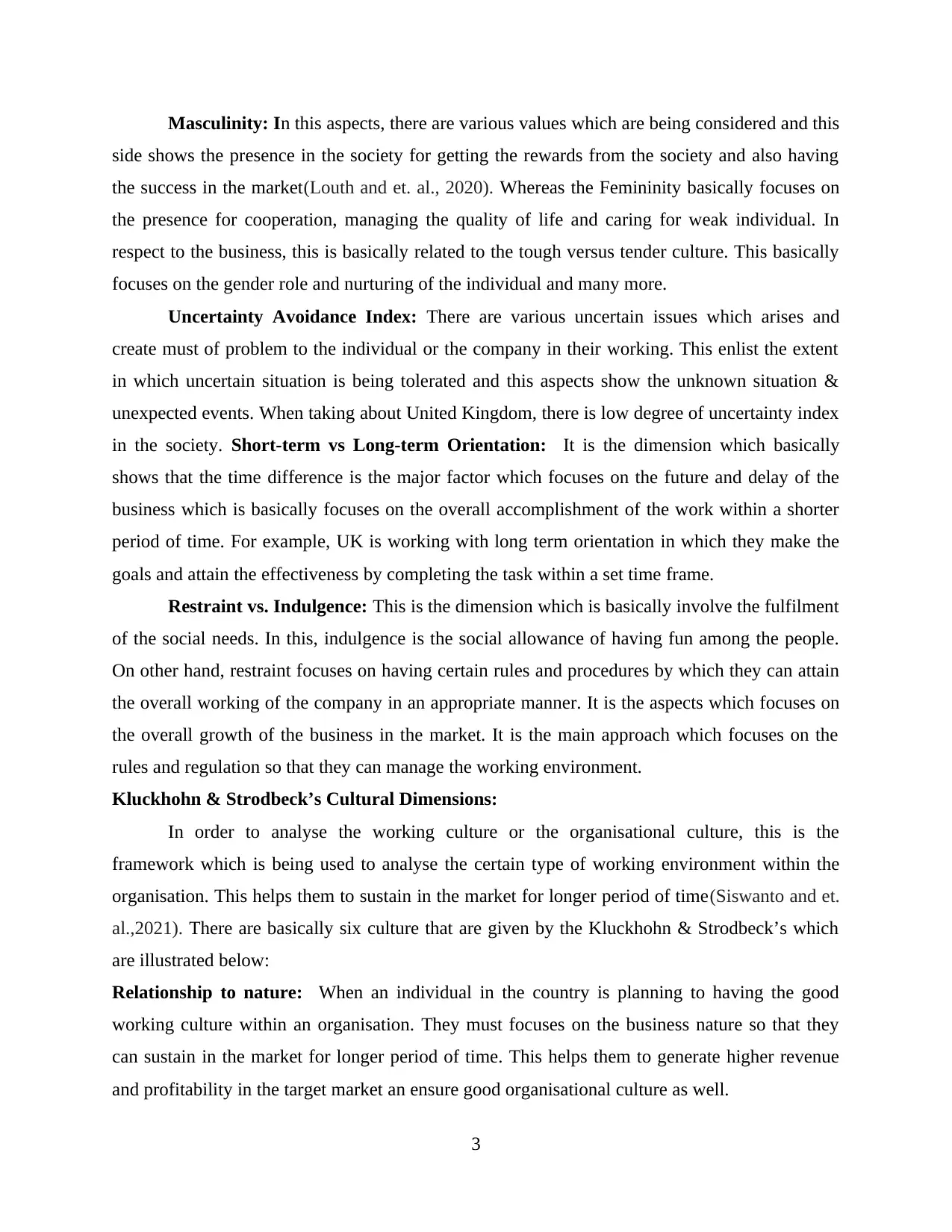
Masculinity: In this aspects, there are various values which are being considered and this
side shows the presence in the society for getting the rewards from the society and also having
the success in the market(Louth and et. al., 2020). Whereas the Femininity basically focuses on
the presence for cooperation, managing the quality of life and caring for weak individual. In
respect to the business, this is basically related to the tough versus tender culture. This basically
focuses on the gender role and nurturing of the individual and many more.
Uncertainty Avoidance Index: There are various uncertain issues which arises and
create must of problem to the individual or the company in their working. This enlist the extent
in which uncertain situation is being tolerated and this aspects show the unknown situation &
unexpected events. When taking about United Kingdom, there is low degree of uncertainty index
in the society. Short-term vs Long-term Orientation: It is the dimension which basically
shows that the time difference is the major factor which focuses on the future and delay of the
business which is basically focuses on the overall accomplishment of the work within a shorter
period of time. For example, UK is working with long term orientation in which they make the
goals and attain the effectiveness by completing the task within a set time frame.
Restraint vs. Indulgence: This is the dimension which is basically involve the fulfilment
of the social needs. In this, indulgence is the social allowance of having fun among the people.
On other hand, restraint focuses on having certain rules and procedures by which they can attain
the overall working of the company in an appropriate manner. It is the aspects which focuses on
the overall growth of the business in the market. It is the main approach which focuses on the
rules and regulation so that they can manage the working environment.
Kluckhohn & Strodbeck’s Cultural Dimensions:
In order to analyse the working culture or the organisational culture, this is the
framework which is being used to analyse the certain type of working environment within the
organisation. This helps them to sustain in the market for longer period of time(Siswanto and et.
al.,2021). There are basically six culture that are given by the Kluckhohn & Strodbeck’s which
are illustrated below:
Relationship to nature: When an individual in the country is planning to having the good
working culture within an organisation. They must focuses on the business nature so that they
can sustain in the market for longer period of time. This helps them to generate higher revenue
and profitability in the target market an ensure good organisational culture as well.
3
side shows the presence in the society for getting the rewards from the society and also having
the success in the market(Louth and et. al., 2020). Whereas the Femininity basically focuses on
the presence for cooperation, managing the quality of life and caring for weak individual. In
respect to the business, this is basically related to the tough versus tender culture. This basically
focuses on the gender role and nurturing of the individual and many more.
Uncertainty Avoidance Index: There are various uncertain issues which arises and
create must of problem to the individual or the company in their working. This enlist the extent
in which uncertain situation is being tolerated and this aspects show the unknown situation &
unexpected events. When taking about United Kingdom, there is low degree of uncertainty index
in the society. Short-term vs Long-term Orientation: It is the dimension which basically
shows that the time difference is the major factor which focuses on the future and delay of the
business which is basically focuses on the overall accomplishment of the work within a shorter
period of time. For example, UK is working with long term orientation in which they make the
goals and attain the effectiveness by completing the task within a set time frame.
Restraint vs. Indulgence: This is the dimension which is basically involve the fulfilment
of the social needs. In this, indulgence is the social allowance of having fun among the people.
On other hand, restraint focuses on having certain rules and procedures by which they can attain
the overall working of the company in an appropriate manner. It is the aspects which focuses on
the overall growth of the business in the market. It is the main approach which focuses on the
rules and regulation so that they can manage the working environment.
Kluckhohn & Strodbeck’s Cultural Dimensions:
In order to analyse the working culture or the organisational culture, this is the
framework which is being used to analyse the certain type of working environment within the
organisation. This helps them to sustain in the market for longer period of time(Siswanto and et.
al.,2021). There are basically six culture that are given by the Kluckhohn & Strodbeck’s which
are illustrated below:
Relationship to nature: When an individual in the country is planning to having the good
working culture within an organisation. They must focuses on the business nature so that they
can sustain in the market for longer period of time. This helps them to generate higher revenue
and profitability in the target market an ensure good organisational culture as well.
3
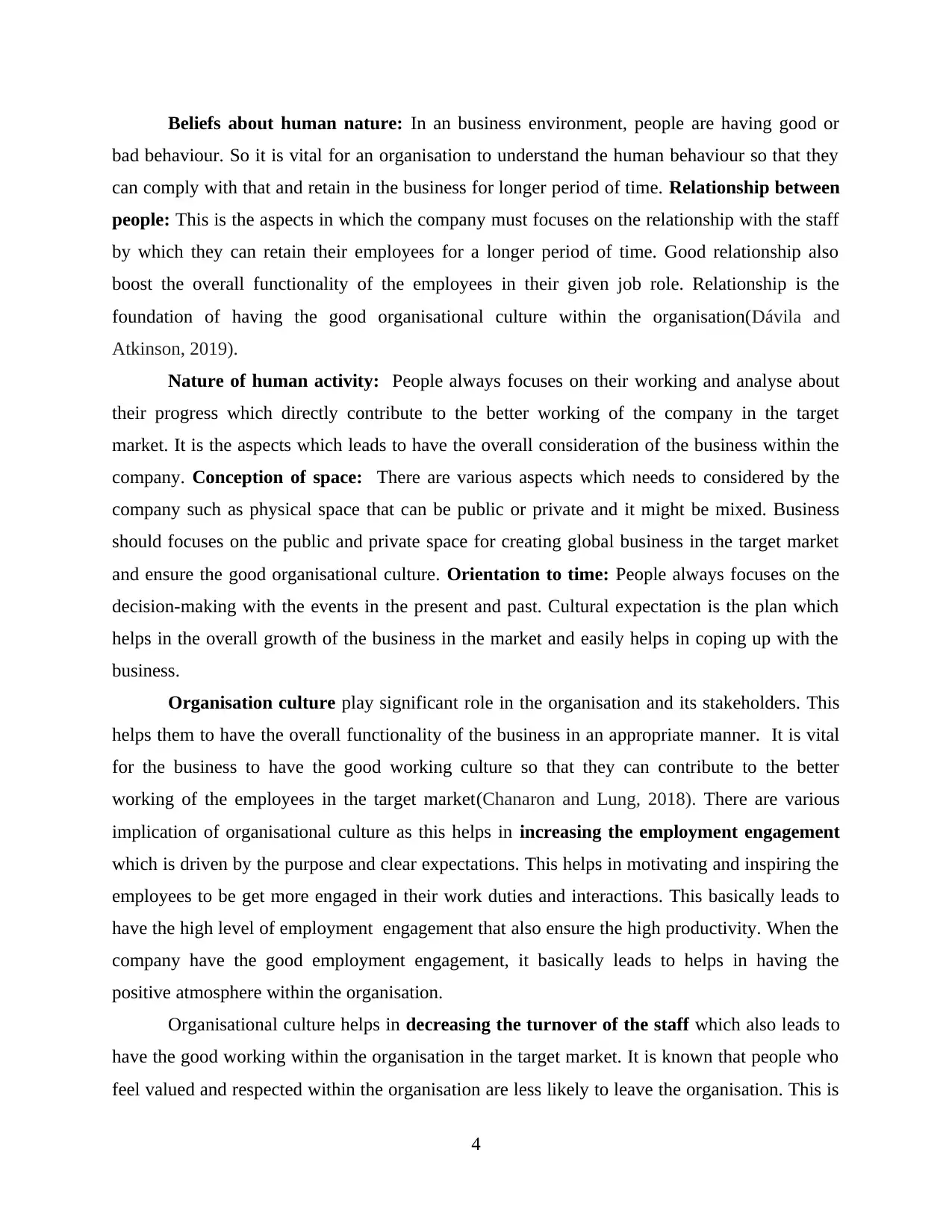
Beliefs about human nature: In an business environment, people are having good or
bad behaviour. So it is vital for an organisation to understand the human behaviour so that they
can comply with that and retain in the business for longer period of time. Relationship between
people: This is the aspects in which the company must focuses on the relationship with the staff
by which they can retain their employees for a longer period of time. Good relationship also
boost the overall functionality of the employees in their given job role. Relationship is the
foundation of having the good organisational culture within the organisation(Dávila and
Atkinson, 2019).
Nature of human activity: People always focuses on their working and analyse about
their progress which directly contribute to the better working of the company in the target
market. It is the aspects which leads to have the overall consideration of the business within the
company. Conception of space: There are various aspects which needs to considered by the
company such as physical space that can be public or private and it might be mixed. Business
should focuses on the public and private space for creating global business in the target market
and ensure the good organisational culture. Orientation to time: People always focuses on the
decision-making with the events in the present and past. Cultural expectation is the plan which
helps in the overall growth of the business in the market and easily helps in coping up with the
business.
Organisation culture play significant role in the organisation and its stakeholders. This
helps them to have the overall functionality of the business in an appropriate manner. It is vital
for the business to have the good working culture so that they can contribute to the better
working of the employees in the target market(Chanaron and Lung, 2018). There are various
implication of organisational culture as this helps in increasing the employment engagement
which is driven by the purpose and clear expectations. This helps in motivating and inspiring the
employees to be get more engaged in their work duties and interactions. This basically leads to
have the high level of employment engagement that also ensure the high productivity. When the
company have the good employment engagement, it basically leads to helps in having the
positive atmosphere within the organisation.
Organisational culture helps in decreasing the turnover of the staff which also leads to
have the good working within the organisation in the target market. It is known that people who
feel valued and respected within the organisation are less likely to leave the organisation. This is
4
bad behaviour. So it is vital for an organisation to understand the human behaviour so that they
can comply with that and retain in the business for longer period of time. Relationship between
people: This is the aspects in which the company must focuses on the relationship with the staff
by which they can retain their employees for a longer period of time. Good relationship also
boost the overall functionality of the employees in their given job role. Relationship is the
foundation of having the good organisational culture within the organisation(Dávila and
Atkinson, 2019).
Nature of human activity: People always focuses on their working and analyse about
their progress which directly contribute to the better working of the company in the target
market. It is the aspects which leads to have the overall consideration of the business within the
company. Conception of space: There are various aspects which needs to considered by the
company such as physical space that can be public or private and it might be mixed. Business
should focuses on the public and private space for creating global business in the target market
and ensure the good organisational culture. Orientation to time: People always focuses on the
decision-making with the events in the present and past. Cultural expectation is the plan which
helps in the overall growth of the business in the market and easily helps in coping up with the
business.
Organisation culture play significant role in the organisation and its stakeholders. This
helps them to have the overall functionality of the business in an appropriate manner. It is vital
for the business to have the good working culture so that they can contribute to the better
working of the employees in the target market(Chanaron and Lung, 2018). There are various
implication of organisational culture as this helps in increasing the employment engagement
which is driven by the purpose and clear expectations. This helps in motivating and inspiring the
employees to be get more engaged in their work duties and interactions. This basically leads to
have the high level of employment engagement that also ensure the high productivity. When the
company have the good employment engagement, it basically leads to helps in having the
positive atmosphere within the organisation.
Organisational culture helps in decreasing the turnover of the staff which also leads to
have the good working within the organisation in the target market. It is known that people who
feel valued and respected within the organisation are less likely to leave the organisation. This is
4
⊘ This is a preview!⊘
Do you want full access?
Subscribe today to unlock all pages.

Trusted by 1+ million students worldwide
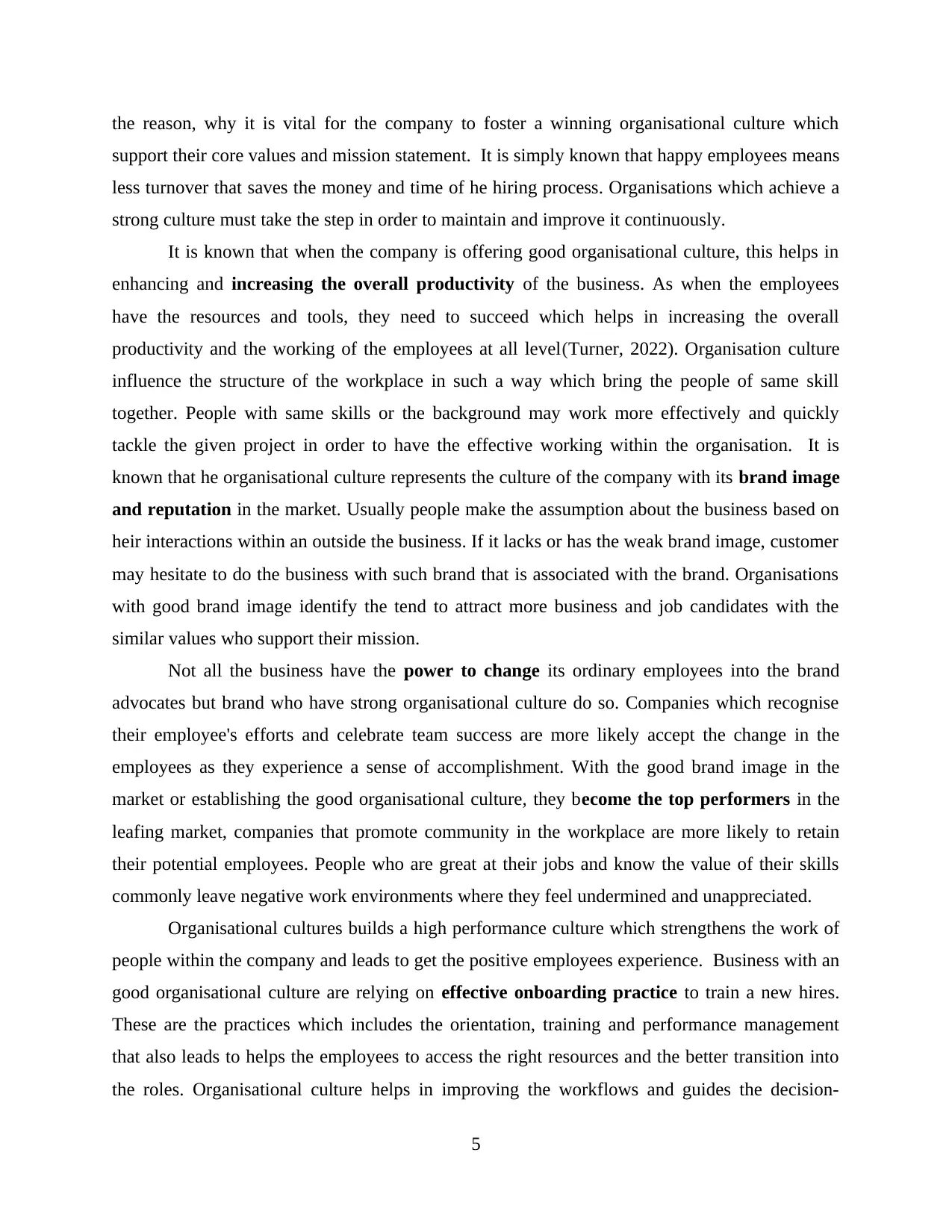
the reason, why it is vital for the company to foster a winning organisational culture which
support their core values and mission statement. It is simply known that happy employees means
less turnover that saves the money and time of he hiring process. Organisations which achieve a
strong culture must take the step in order to maintain and improve it continuously.
It is known that when the company is offering good organisational culture, this helps in
enhancing and increasing the overall productivity of the business. As when the employees
have the resources and tools, they need to succeed which helps in increasing the overall
productivity and the working of the employees at all level(Turner, 2022). Organisation culture
influence the structure of the workplace in such a way which bring the people of same skill
together. People with same skills or the background may work more effectively and quickly
tackle the given project in order to have the effective working within the organisation. It is
known that he organisational culture represents the culture of the company with its brand image
and reputation in the market. Usually people make the assumption about the business based on
heir interactions within an outside the business. If it lacks or has the weak brand image, customer
may hesitate to do the business with such brand that is associated with the brand. Organisations
with good brand image identify the tend to attract more business and job candidates with the
similar values who support their mission.
Not all the business have the power to change its ordinary employees into the brand
advocates but brand who have strong organisational culture do so. Companies which recognise
their employee's efforts and celebrate team success are more likely accept the change in the
employees as they experience a sense of accomplishment. With the good brand image in the
market or establishing the good organisational culture, they become the top performers in the
leafing market, companies that promote community in the workplace are more likely to retain
their potential employees. People who are great at their jobs and know the value of their skills
commonly leave negative work environments where they feel undermined and unappreciated.
Organisational cultures builds a high performance culture which strengthens the work of
people within the company and leads to get the positive employees experience. Business with an
good organisational culture are relying on effective onboarding practice to train a new hires.
These are the practices which includes the orientation, training and performance management
that also leads to helps the employees to access the right resources and the better transition into
the roles. Organisational culture helps in improving the workflows and guides the decision-
5
support their core values and mission statement. It is simply known that happy employees means
less turnover that saves the money and time of he hiring process. Organisations which achieve a
strong culture must take the step in order to maintain and improve it continuously.
It is known that when the company is offering good organisational culture, this helps in
enhancing and increasing the overall productivity of the business. As when the employees
have the resources and tools, they need to succeed which helps in increasing the overall
productivity and the working of the employees at all level(Turner, 2022). Organisation culture
influence the structure of the workplace in such a way which bring the people of same skill
together. People with same skills or the background may work more effectively and quickly
tackle the given project in order to have the effective working within the organisation. It is
known that he organisational culture represents the culture of the company with its brand image
and reputation in the market. Usually people make the assumption about the business based on
heir interactions within an outside the business. If it lacks or has the weak brand image, customer
may hesitate to do the business with such brand that is associated with the brand. Organisations
with good brand image identify the tend to attract more business and job candidates with the
similar values who support their mission.
Not all the business have the power to change its ordinary employees into the brand
advocates but brand who have strong organisational culture do so. Companies which recognise
their employee's efforts and celebrate team success are more likely accept the change in the
employees as they experience a sense of accomplishment. With the good brand image in the
market or establishing the good organisational culture, they become the top performers in the
leafing market, companies that promote community in the workplace are more likely to retain
their potential employees. People who are great at their jobs and know the value of their skills
commonly leave negative work environments where they feel undermined and unappreciated.
Organisational cultures builds a high performance culture which strengthens the work of
people within the company and leads to get the positive employees experience. Business with an
good organisational culture are relying on effective onboarding practice to train a new hires.
These are the practices which includes the orientation, training and performance management
that also leads to helps the employees to access the right resources and the better transition into
the roles. Organisational culture helps in improving the workflows and guides the decision-
5
Paraphrase This Document
Need a fresh take? Get an instant paraphrase of this document with our AI Paraphraser
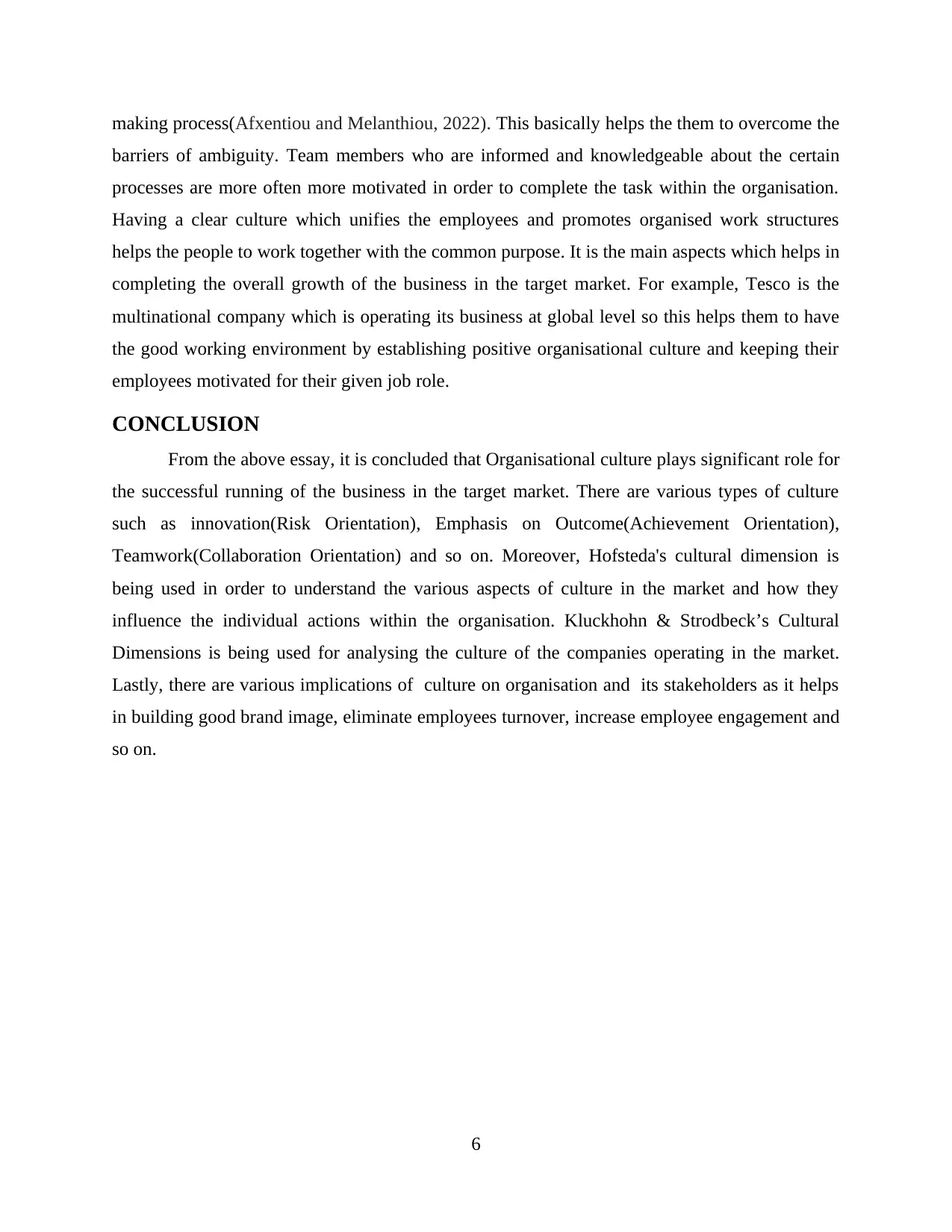
making process(Afxentiou and Melanthiou, 2022). This basically helps the them to overcome the
barriers of ambiguity. Team members who are informed and knowledgeable about the certain
processes are more often more motivated in order to complete the task within the organisation.
Having a clear culture which unifies the employees and promotes organised work structures
helps the people to work together with the common purpose. It is the main aspects which helps in
completing the overall growth of the business in the target market. For example, Tesco is the
multinational company which is operating its business at global level so this helps them to have
the good working environment by establishing positive organisational culture and keeping their
employees motivated for their given job role.
CONCLUSION
From the above essay, it is concluded that Organisational culture plays significant role for
the successful running of the business in the target market. There are various types of culture
such as innovation(Risk Orientation), Emphasis on Outcome(Achievement Orientation),
Teamwork(Collaboration Orientation) and so on. Moreover, Hofsteda's cultural dimension is
being used in order to understand the various aspects of culture in the market and how they
influence the individual actions within the organisation. Kluckhohn & Strodbeck’s Cultural
Dimensions is being used for analysing the culture of the companies operating in the market.
Lastly, there are various implications of culture on organisation and its stakeholders as it helps
in building good brand image, eliminate employees turnover, increase employee engagement and
so on.
6
barriers of ambiguity. Team members who are informed and knowledgeable about the certain
processes are more often more motivated in order to complete the task within the organisation.
Having a clear culture which unifies the employees and promotes organised work structures
helps the people to work together with the common purpose. It is the main aspects which helps in
completing the overall growth of the business in the target market. For example, Tesco is the
multinational company which is operating its business at global level so this helps them to have
the good working environment by establishing positive organisational culture and keeping their
employees motivated for their given job role.
CONCLUSION
From the above essay, it is concluded that Organisational culture plays significant role for
the successful running of the business in the target market. There are various types of culture
such as innovation(Risk Orientation), Emphasis on Outcome(Achievement Orientation),
Teamwork(Collaboration Orientation) and so on. Moreover, Hofsteda's cultural dimension is
being used in order to understand the various aspects of culture in the market and how they
influence the individual actions within the organisation. Kluckhohn & Strodbeck’s Cultural
Dimensions is being used for analysing the culture of the companies operating in the market.
Lastly, there are various implications of culture on organisation and its stakeholders as it helps
in building good brand image, eliminate employees turnover, increase employee engagement and
so on.
6
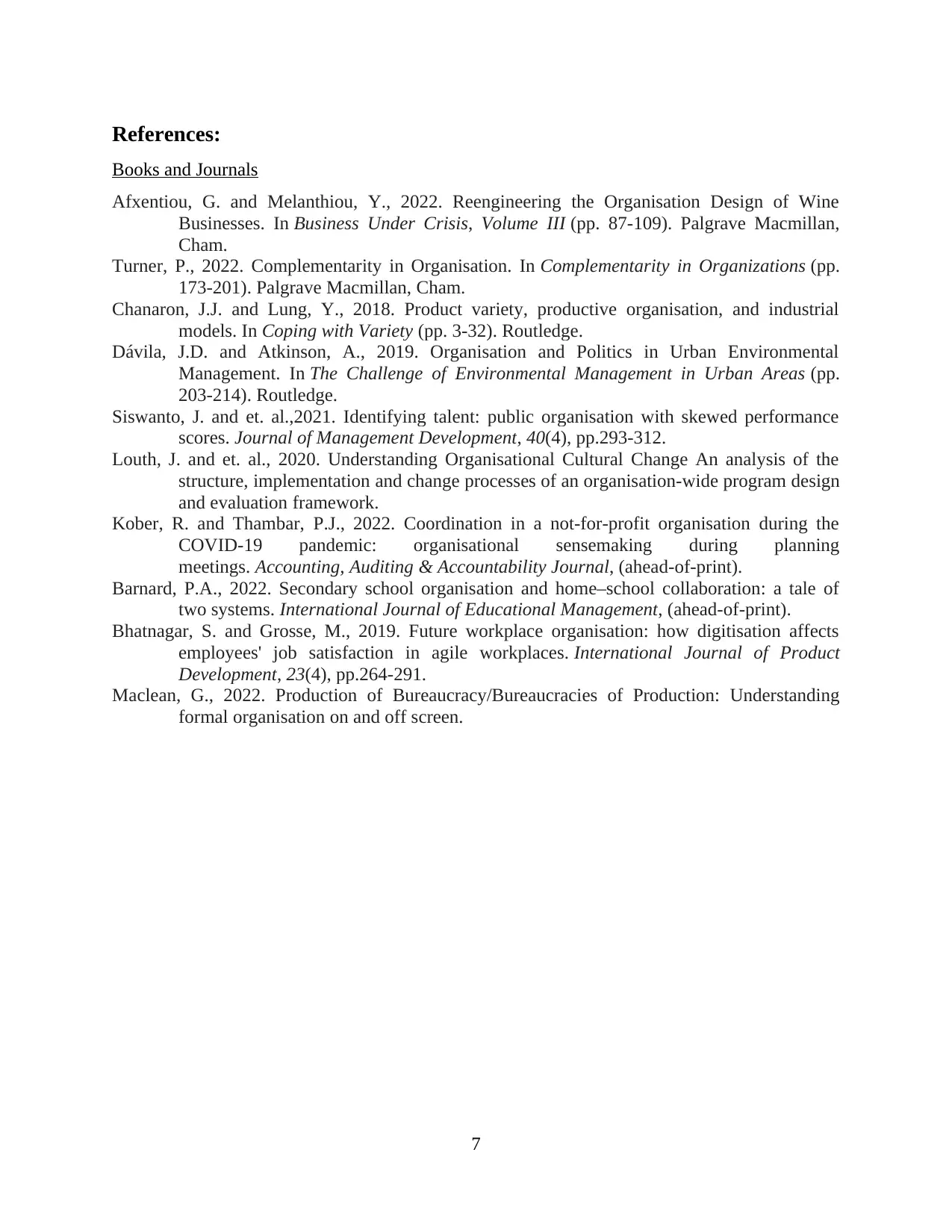
References:
Books and Journals
Afxentiou, G. and Melanthiou, Y., 2022. Reengineering the Organisation Design of Wine
Businesses. In Business Under Crisis, Volume III (pp. 87-109). Palgrave Macmillan,
Cham.
Turner, P., 2022. Complementarity in Organisation. In Complementarity in Organizations (pp.
173-201). Palgrave Macmillan, Cham.
Chanaron, J.J. and Lung, Y., 2018. Product variety, productive organisation, and industrial
models. In Coping with Variety (pp. 3-32). Routledge.
Dávila, J.D. and Atkinson, A., 2019. Organisation and Politics in Urban Environmental
Management. In The Challenge of Environmental Management in Urban Areas (pp.
203-214). Routledge.
Siswanto, J. and et. al.,2021. Identifying talent: public organisation with skewed performance
scores. Journal of Management Development, 40(4), pp.293-312.
Louth, J. and et. al., 2020. Understanding Organisational Cultural Change An analysis of the
structure, implementation and change processes of an organisation-wide program design
and evaluation framework.
Kober, R. and Thambar, P.J., 2022. Coordination in a not-for-profit organisation during the
COVID-19 pandemic: organisational sensemaking during planning
meetings. Accounting, Auditing & Accountability Journal, (ahead-of-print).
Barnard, P.A., 2022. Secondary school organisation and home–school collaboration: a tale of
two systems. International Journal of Educational Management, (ahead-of-print).
Bhatnagar, S. and Grosse, M., 2019. Future workplace organisation: how digitisation affects
employees' job satisfaction in agile workplaces. International Journal of Product
Development, 23(4), pp.264-291.
Maclean, G., 2022. Production of Bureaucracy/Bureaucracies of Production: Understanding
formal organisation on and off screen.
7
Books and Journals
Afxentiou, G. and Melanthiou, Y., 2022. Reengineering the Organisation Design of Wine
Businesses. In Business Under Crisis, Volume III (pp. 87-109). Palgrave Macmillan,
Cham.
Turner, P., 2022. Complementarity in Organisation. In Complementarity in Organizations (pp.
173-201). Palgrave Macmillan, Cham.
Chanaron, J.J. and Lung, Y., 2018. Product variety, productive organisation, and industrial
models. In Coping with Variety (pp. 3-32). Routledge.
Dávila, J.D. and Atkinson, A., 2019. Organisation and Politics in Urban Environmental
Management. In The Challenge of Environmental Management in Urban Areas (pp.
203-214). Routledge.
Siswanto, J. and et. al.,2021. Identifying talent: public organisation with skewed performance
scores. Journal of Management Development, 40(4), pp.293-312.
Louth, J. and et. al., 2020. Understanding Organisational Cultural Change An analysis of the
structure, implementation and change processes of an organisation-wide program design
and evaluation framework.
Kober, R. and Thambar, P.J., 2022. Coordination in a not-for-profit organisation during the
COVID-19 pandemic: organisational sensemaking during planning
meetings. Accounting, Auditing & Accountability Journal, (ahead-of-print).
Barnard, P.A., 2022. Secondary school organisation and home–school collaboration: a tale of
two systems. International Journal of Educational Management, (ahead-of-print).
Bhatnagar, S. and Grosse, M., 2019. Future workplace organisation: how digitisation affects
employees' job satisfaction in agile workplaces. International Journal of Product
Development, 23(4), pp.264-291.
Maclean, G., 2022. Production of Bureaucracy/Bureaucracies of Production: Understanding
formal organisation on and off screen.
7
⊘ This is a preview!⊘
Do you want full access?
Subscribe today to unlock all pages.

Trusted by 1+ million students worldwide
1 out of 9
Related Documents
Your All-in-One AI-Powered Toolkit for Academic Success.
+13062052269
info@desklib.com
Available 24*7 on WhatsApp / Email
![[object Object]](/_next/static/media/star-bottom.7253800d.svg)
Unlock your academic potential
Copyright © 2020–2025 A2Z Services. All Rights Reserved. Developed and managed by ZUCOL.



![Argumentative Essay on Organizational Behaviour - [University Name]](/_next/image/?url=https%3A%2F%2Fdesklib.com%2Fmedia%2Fimages%2Fhj%2Fb90705dcd0914a5ca9afd01837d6f50c.jpg&w=256&q=75)
